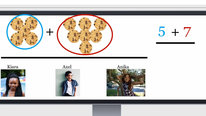- Ashley Gannon
- https://people.sc.fsu.edu/~ag12s/
- Graduate Student
- Presenter’s NSFRESOURCECENTERS
- Florida State University
- Matthew Mauntel
- Graduate Student
- Presenter’s NSFRESOURCECENTERS
- Florida State University
- Jessica Smith
- Graduate Student
- Presenter’s NSFRESOURCECENTERS
- Florida State University
Computer Science Integrated with Mathematics in Middle Schools (CSIMMS)
NSF Awards: 1640039
2020 (see original presentation & discussion)
Grades 6-8
Computer Science Integrated with Mathematics in Middle School (CSIMMS) is a collaborative project between middle school Mathematics teachers, FSU Computer Science faculty, and STEM education faculty to design, develop, and implement modules in middle school mathematics courses that integrate computer science. Our broader project identifies design principles for the development of such integrative modules and documents what is needed for schools and teachers to successfully implement them. This informs what it takes to broaden participation in computer science via integration with mathematics. Our video features examples of programs written by students in the context of the project’s curricular materials. We discuss mathematics and computer science ideas featured in these examples.
Related Content for Computer Science Integrated w/ Mathematics in Middle Schools
-
 2021Computer Science integrated with Mathematics in MS
2021Computer Science integrated with Mathematics in MS
Jessica Smith
-
 2020Coding Science Internship Units: CS for Science Classrooms
2020Coding Science Internship Units: CS for Science Classrooms
Ari Krakowski
-
 2019Coding Science Internship: CS for the Science Classroom
2019Coding Science Internship: CS for the Science Classroom
Ari Krakowski
-
 2022Computer Science Integrated with Math in Middle Schools
2022Computer Science Integrated with Math in Middle Schools
Ashley Gannon
-
 2019Integrating Computational Thinking in Elementary Science
2019Integrating Computational Thinking in Elementary Science
Kevin Waterman
-
 2020Highlighting Science Practices in First Grade Classrooms
2020Highlighting Science Practices in First Grade Classrooms
Kevin Waterman
-
 2020SchoolWide Labs: Integrating CT into science using sensors
2020SchoolWide Labs: Integrating CT into science using sensors
Quentin Biddy
-
 2020AMP-IT-UP: Inspiring middle school teachers in STEM
2020AMP-IT-UP: Inspiring middle school teachers in STEM
Meltem Alemdar



James Brown
5/6 STEM Teacher
I like the idea of integrating computer science with mathematics. How do you plan on disseminating this information to a broader network of teachers?
Jessica Smith
Graduate Student
Hi James! We are finishing refining the modules now with the data we have from several iterations. We hope to post them on our website (https://csimms.cs.fsu.edu/) at some point over the summer.
James Brown
Dave Miller
Exciting project! Great to see how this is being integrated with K-12 MS Math. Also caught the use of Scratch for the story telling, in the video - very cool. Wondering if part of your work might be at the intersection of ELA classrooms, Math classrooms, and work with in the ELL realm? Thanks for sharing your work here, in the NSF SFA.
Jessica Smith
Graduate Student
Great Question! Currently, we are not looking at that intersection, but it is a great suggestion for future research.
Jessica Smith
Graduate Student
Yes, that is a really nice question. Currently, our focus has been on developing and refining 12 modules, but your idea would be interesting for the future!
Chih-Pu Dai
This is such a cool project! I liked how you share the idea of "computer science and mathematics can enhance each other." I am curious about the technologies used in the modules, mainly Scratch? In addition, what are the materials in the modules (e.g., are there facilitators'/ teachers' guide)? The students' example in the video looks fantastic!
Jessica Smith
Graduate Student
Hi Chih-Pu and thanks for the questions! The only technology used in the modules regarding coding is Scratch. We starting to include some videos in the modules that could be used as tutorials, though. We have made student tasks and teacher guides for each module, but are currently working on more detailed teacher guides that aren't too long but have enough in them to assist in implementing any of the modules. We're hoping we might be able to make a workbook of sorts!
Chih-Pu Dai
DeLene Hoffner
Program Coordinator
What a wonderful project! I wondered what you found to be your greatest challenge?
Jessica Smith
Graduate Student
Thank you DeLene for the question. One of the greatest challenges we found while trying to get teachers to implement the modules was convincing teachers that the modules could be used instead of their standard lessons on the subject as opposed to just supplemental material. It greatly helped that we had one teacher who was willing to take a risk and use the modules to introduce material early in the project and she had some great success. She helped convince other teachers in the project to take a chance on the modules as replacements for standard lessons.
One key aspect that the teachers helped quite a bit with was refining the coding exercises so that the students could see required mathematics in the code. To give you an example, we have a unit on geometric transformations and there are many different ways a reflection can be programmed in Scratch. Finding an exercise that not only had the students reflect an object, but also having that exercise produce coding variants that were relevant to the standards relating reflections and coordinates was a bit of a challenge. This is where the implementing teachers were great and provided great feedback that helped with the designing and refining of the modules. A big thank you goes out to all of them.
DeLene Hoffner
Stacey Forsyth
Director
It's great to see Scratch being integrated into mathematics classrooms. Can you share more about what this looks like in a teacher's classroom? Are the different modules integrated into the class at different points throughout the year, to complement the curriculum, or is this integrated as its own Scratch unit? Also, can you share more about how you're evaluating the impacts of the program? Are you measuring gains in students' understanding of math or coding concepts, or are you focusing more on the teachers?
Jessica Smith
Graduate Student
Stacy, thank you for your interest! Implementation in the teachers' classrooms varied greatly. Some classrooms utilized smartboards to display student code with accompanying discussions. Others gave the students the modules and let them work largely independently and there was everything in between. The classrooms varied greatly as well with several of the implementation classrooms being in low SES schools.
The modules were implemented at different points in the year and were designed to replace the lessons when they appeared in the curriculum. We did have some teachers who used the modules in a more supplemental way as either an introduction to the material or revisiting the material after it had been covered in class.
In terms of evaluating the learning gains from the program, we collected a pre-assessment math question and a post-module assessment with questions about math, computational thinking, and programming. We also gave students a pre/post MISO survey to evaluate the program's impact on student attitudes towards STEM. In addition, we also looking at the impact on the instructors and have pre and post-implementation interviews, recordings of their classroom implementation, as well as pre/post-implementation MISOs.
DeLene Hoffner
DeLene Hoffner
Program Coordinator
When you gave students a pre/post MISO survey to evaluate the program's impact on student attitudes towards STEM, what were the top findings?
Jessica Smith
Graduate Student
Hi Delene! We're actually in the process of analyzing the MISO data currently. We're hoping to be able to answer questions like yours by the end of the summer! We have a lot of data that we're trying to sift through in the coming months.
Michael Horn
Really glad to see serious work being done at the intersection of CS and mathematics, especially for middle school students. I'll definitely check out the curriculum materials.
DeLene Hoffner
Jessica Smith
Graduate Student
Hi, Michael! We're not exactly sure how we're going to disseminate the modules, but you can definitely keep up with things on our website (https://csimms.cs.fsu.edu/).
DeLene Hoffner
Program Coordinator
So often, subjects are taught in isolation. The foundation of your program is so inspiring and relevant. I'm impressed that Computer Science is integrated with Mathematics and STEM. The team working together is a powerful way to design, develop, and implement modules. How did the planning for this come together with so many different departments/ teachers?
Ashley Gannon
Graduate Student
Dr. Ellen Granger has done quite a bit of interdisciplinary work. When she saw the RFP for the STEM+C grants, she put the interdisciplinary team together. She selected folks who have a personality to work well together. When schools were selected, they were chosen to represent the community demographics and also under-resourced schools. Math teachers at these schools were invited to participate, and the ones who were interested came on board.
DeLene Hoffner
Program Coordinator
I wondered what "ah-ha's" or discoveries were most profound in your project.
Jessica Smith
Graduate Student
DeLene, great question. I think one of the most ah-ha moments for me was the amount of time students spent personalizing their sprites and telling stories with their project. Also, there were some students who did not seem to enjoy programming in Scratch and it would be interesting to investigate why this is. Finally, creating and refining 12 modules in 3 years is a lot of work.
Further posting is closed as the event has ended.